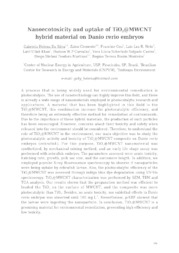Nanoecotoxicity and uptake of TiO2@MWCNT hybrid material on Danio rerio embryos.
Nanoecotoxicity and uptake of TiO2@MWCNT hybrid material on Danio rerio embryos.
Author(s): SILVA, G. H. da; CLEMENTE, Z.; COA, F.; RODRIGUES NETO, L. L.; KHAN, L. U.; CARVALHO, H. W. P.; CASTRO, V. L. S. S. de; MARTINEZ, D. S. T.; MONTEIRO, R. T. R.
Summary: A process that is being widely used for environmental remediation is photocatalysis. The use of nanotechnology can highly improve this field, and there is already a wide range of nanomaterials employed in photocatalytic research and applications. A material that has been highlighted in this field is the TiO2@MWCNT, this combination increase the photocatalytic efficiency, and therefore being an extremely effective method for remediation of contaminants. Due to the importance of these hybrid materials, the production of such particles has been encouraged. However, concerns about their toxicity and safety when released into the environment should be considered. Therefore, to understand the role of TiO2@MWCNT in the environment, our main objective was to study the photocatalytic activity and toxicity of TiO2@MWCNT composite on Danio rerio embryos (zebrafish). For this purpose, TiO2@MWCNT nanomaterial was synthetized, by mechanical mixing method, and an early life stage assay was performed with zebrafish embryos. The parameters assessed were acute toxicity, hatching rate, growth, yolk sac size, and the sarcomere length. In addition, we employed ?-probe X-ray fluorescence spectroscopy to observe if nanoparticles were being uptake by zebrafish larvae. Also, the photocatalytic efficiency of the TiO2@MWCNT was assessed through indigo blue dye degradation using UV-Vis spectroscopy. TiO2@MWCNT characterization was performed by SEM, TEM and TGA analysis. Our results shown that the preparation method was efficient to loaded the TiO2 on the surface of MWCNT, and the composite was more photocatalytic than TiO2. Besides, no acute toxicity, nor sublethal effects in Danio rerio embryos was observed until 100 mg L-1. Nevertheless, µ-XRF showed that the larvae were ingesting the nanoparticle. In conclusion, TiO2@MWCNT is a promising material for environmental remediation, presenting high efficiency and low toxicity.
Publication year: 2017
Types of publication: Abstract in annals or event proceedings
Unit: Embrapa Environment
Keywords: Danio rerio, Nanoecotoxicologia
Observation
Some of Embrapa's publications are published as ePub files. To read them, use or download one of the following free software options to your computer or mobile device. Android: Google Play Books; IOS: iBooks; Windows and Linux: Calibre.
Access other publications
Access the Agricultural Research Database (BDPA) to consult Embrapa's full library collection and records.
Visit Embrapa Bookstore to purchase books and other publications sold by Embrapa.

